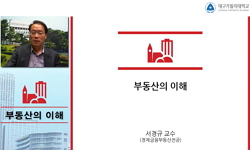Through Chapter 2, some historical evidences are addressed to help understand the uniqueness of Korean real estate market. How Korean War in 1950 affected real estate market in Korea and the aftermaths of the impact are addressed. Government’s effor...
http://chineseinput.net/에서 pinyin(병음)방식으로 중국어를 변환할 수 있습니다.
변환된 중국어를 복사하여 사용하시면 됩니다.
- 中文 을 입력하시려면 zhongwen을 입력하시고 space를누르시면됩니다.
- 北京 을 입력하시려면 beijing을 입력하시고 space를 누르시면 됩니다.
https://www.riss.kr/link?id=T7916207
- 저자
-
발행사항
Seoul : Graduate School of International Studies, Yonsei University, 2001
-
학위논문사항
Thesis(M.A.) -- Graduate School of International Studies, Yonsei University , Major in Business Administration , 2001. 2
-
발행연도
2001
-
작성언어
영어
- 주제어
-
KDC
321.329 판사항(4)
-
발행국(도시)
대한민국
-
형태사항
84p. : Illustrations ; 26 cm.
- 소장기관
-
0
상세조회 -
0
다운로드
부가정보
다국어 초록 (Multilingual Abstract)
Chapter 3 addresses the finance theory and its application to real estate investments. The principles of finance that have commonly applied to an analysis of corporate finance can easily be applied to real estate finance. The principles of asset valuation apply to real estate, mortgages, and other real-estaterelated securities. Leverage, whereby debt is used to increase the value of equity contributions, is also applied to real estate investment. The theory of financial intermediation is important for understanding the role, success, and failures of intermediaries. Real estate assets can be combined by themselves, or with other assets, in portfolios that reduce risk. Large institutional investors such as pension funds and life insurance companies, explore their risk-reducing opportunities when they invest in real estate. The uniqueness of real estate properties and lack of widespread knowledge of all relevant facts allow for some in-efficiencies. There is evidence that this leads to excess returns for some real estate investors. Agency problems and costs to monitor agents are also present in real estate. Contracts and an intricate system of laws address client-agency problems.
Chapter 4 shows how all finance theories and Korean real estate characteristics are applied in practice using a case study of an investment analysis on a commercial property. Although the formats presented in the case study are only a part of property analysis, it serves to focus on return analysis and valuation, the most important part of real estate investment. At the end of the chapter, the weighted average of cost of capital (WACC) for the investment is discussed to provide a benchmark that gives the idea of whether the investment is attractive enough to cover the minimum required rate of return.
Through Chapter 2, some historical evidences are addressed to help understand the uniqueness of Korean real estate market. How Korean War in 1950 affected real estate market in Korea and the aftermaths of the impact are addressed. Government’s efforts to control real estate market coupled with several stages of economic development plans surely played a major role in shaping Korean real estate market after the war. Entire nation was obsessed with the desire to own any form of real estate, which in turn blinded people from seeing the risks involved in it. In 1997, the country was hard hit by the debacle of Korean economy by which people began to realize that the value of real estate could go down. It was a harsh but essential lesson for Korean people. The fact that the value of real estate could go down brought out the need for the technique to evaluate real estate value based on their cash flows. Chapter 2 also introduces some practical knowledge that are essential to understand the real estate market in Korea..
Chapter 3 addresses the finance theory and its application to real estate investments. The principles of finance that have commonly applied to an analysis of corporate finance can easily be applied to real estate finance. The principles of asset valuation apply to real estate, mortgages, and other real-estaterelated securities. Leverage, whereby debt is used to increase the value of equity contributions, is also applied to real estate investment. The theory of financial intermediation is important for understanding the role, success, and failures of intermediaries. Real estate assets can be combined by themselves, or with other assets, in portfolios that reduce risk. Large institutional investors such as pension funds and life insurance companies, explore their risk-reducing opportunities when they invest in real estate. The uniqueness of real estate properties and lack of widespread knowledge of all relevant facts allow for some in-efficiencies. There is evidence that this leads to excess returns for some real estate investors. Agency problems and costs to monitor agents are also present in real estate. Contracts and an intricate system of laws address client-agency problems.
Chapter 4 shows how all finance theories and Korean real estate characteristics are applied in practice using a case study of an investment analysis on a commercial property. Although the formats presented in the case study are only a part of property analysis, it serves to focus on return analysis and valuation, the most important part of real estate investment. At the end of the chapter, the weighted average of cost of capital (WACC) for the investment is discussed to provide a benchmark that gives the idea of whether the investment is attractive enough to cover the minimum required rate of return.
목차 (Table of Contents)
- Table of Contents
- Abstract
- List of Exhibits
- Chapter 1: Introduction = 1
- 1.1 Research Background & Purpose = 1
- Table of Contents
- Abstract
- List of Exhibits
- Chapter 1: Introduction = 1
- 1.1 Research Background & Purpose = 1
- 1.2 Research Methods = 2
- Chapter 2: Real Estate Market In Korea = 4
- 2.1 The Shaping of Unique Korean Real Estate Market = 5
- 2.2 Korean Rental System (Chonse System) = 9
- 2.3 Office Lease Regulations and Procedures in Korea = 11
- 2.4 The Need of Sophisticated Analyzing Technique to Invest in Real Estate = 13
- Chapter 3: Finance Theory For Real Estate Investment = 16
- 3.1 Conventional Finance Theory and Its Application to Real Estate Investment
- 3.1.1 Conventional Finance and Real Estate Finance = 16
- 3.1.2 Financing in Real Estate Market = 42
- 3.2 Valuation of Real Estate = 45
- 3.3 Practical Considerations in Real Estate Investmentv53
- Chapter 4: Case Study: Return Analysis on a Commercial Property = 64
- Chapter 5: Conclusion = 81
- References = 83












